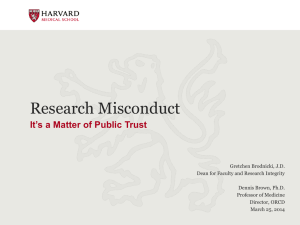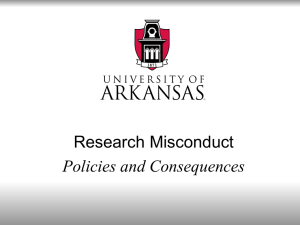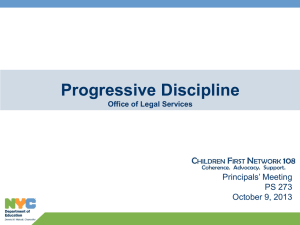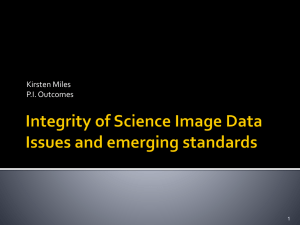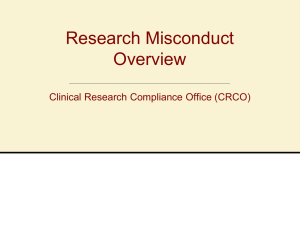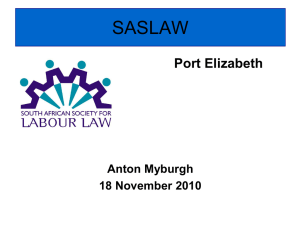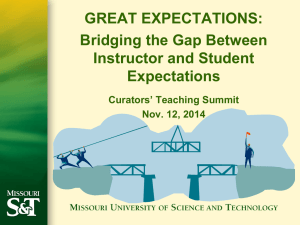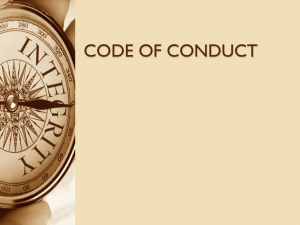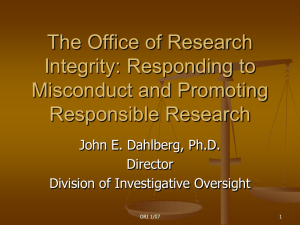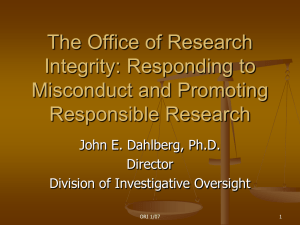Slideshow for Responsible Conduct of Research
advertisement
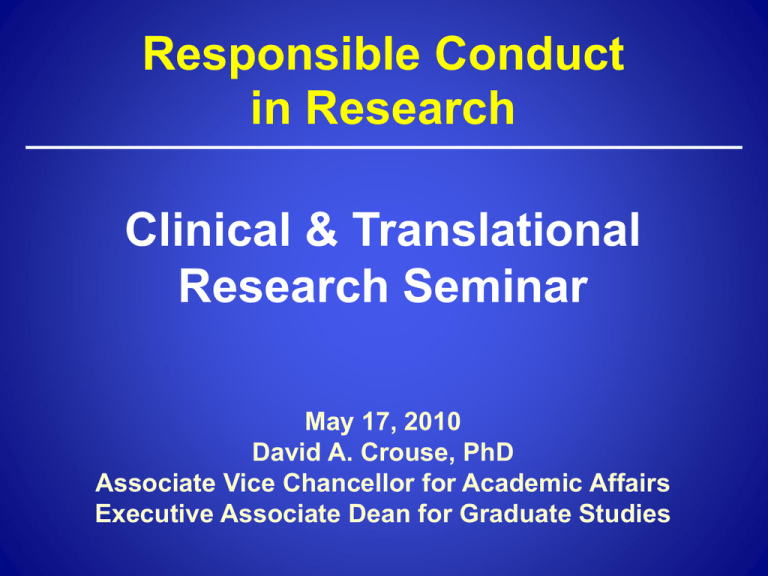
Responsible Conduct in Research Clinical & Translational Research Seminar May 17, 2010 David A. Crouse, PhD Associate Vice Chancellor for Academic Affairs Executive Associate Dean for Graduate Studies Responsible Conduct in Research Why does integrity in all aspects of research matter?” 2 Responsible Conduct in Research Protects research subjects and assets. Maintains integrity of scientific process. Reinforces public support of science and medicine. There is no room for misconduct in the search for “TRUTH”. 3 Responsible Conduct in Research So, What is Responsible Conduct in Research? 4 “Rules of the Road” 5 From ORI website Research Misconduct? “Lying?” “Cheating?” “Stealing?” “Copying?” “Misrepresenting?” “Fudging?” “Cleaning Up Data?” 6 Research Misconduct Defined “Research misconduct is defined as fabrication, falsification, or plagiarism in proposing, performing, or reviewing research, or in reporting research results.” Office of Science and Technology Policy, Federal Policy on Research Misconduct, 2000 DHHS Public Health Service Policies on Research Misconduct, 2005 7 Terms Defined Fabrication is making up data or results and recording or reporting them. Falsification is manipulating research materials, equipment, or processes, or changing or omitting data or results such that the research is not accurately represented in the research record. Plagiarism is the appropriation of another person’s research ideas, processes, results, or words without giving appropriate credit. 8 Research misconduct does not include: Honest error or differences of opinion Authorship disputes Misallocation of resources Evidentiary Standards “A finding of research misconduct requires that: 1. There be a significant departure from accepted practices of the relevant research community; and 2. The research misconduct be committed intentionally, or knowingly, or recklessly; and 3. The allegation be proven by a preponderance of the evidence.” 9 The Possible Range of Events “Honest Error” “Negligent Error” Misconduct “Error” 10 variability haste intentional or knowing or reckless instrument carelessness FFP technique inattention NO EXCUSE What is NOT Research Misconduct? Authorship disputes Determine conditions of authorship ahead of time Dispute resolution is the responsibility of the home institution Self-plagiarism --but watch out for copyright restrictions! Journal editors hold universities accountable 11 But Research Misconduct Rules: DO NOT apply to authorship except for plagiarism. Plagiarism and falsification can be INCLUDED IN: Misrepresentation of personal credentials (i.e., the C.V.) 12 Misrepresentation* of Authorship Among Applicants to Training Programs # # with # pubs Applicants pubs total % pubs invalid Discipline Year Pediatrics1 ‘95 404 147 401 19.7 Radiology2 ‘92-95 201 87 261 15.0 Gastroenterology3 ‘95 236 53 92 30.2 Emergency Medicine4 ‘96 350 113 276 20.4 Orthopaedics5 ‘98-99 213 64 138 18.0 Internal Medicine6 ’02-03 497 234 634 25 - 1.8 Emergency Medicine7 ’02-03 173 47 13.3 •Non-existent or unverifiable journals or books; non-existent articles/chapters; abst, not paper; “in press” but never appeared; inaccurate author position. Ref#6 used different methods 1. Acad Med 73:532, 1998 2. Am J Radiol 170:577, 1998 3. Ann Int Med 123:38, 1995 4. Ann Emerg Med 27:327, 1996 5. J Bone & Joint Surg 81A:1679, 1999 6. Ann Int Med 138:390, 2003 7. Acad Emerg Med 9:992, 2004 13 Institutional Responsibilities Appoint a Research Integrity Officer (RIO) Maintain a Research Misconduct Policy UNMC Policy 8003 “Research Integrity” Provide policy education to all researchers Respond to allegations Conduct an Inquiry and Investigation as appropriate and report to federal funding sources The Omaha VA also has a RIO (Dr. Fred Hamel) and parallel policies 14 Reporting & Responding to Suspected Research Misconduct at UNMC Contact Research Integrity Officer (RIO) May informally discuss concerns RIO determines if suspected misconduct falls within definition; if yes RIO sequesters research records RIO notifies respondent of specific allegations in writing Inquiry conducted – initial fact-finding to determine whether allegation warrants an investigation 15 RIO may appoint committee that includes subject matter experts Reporting & Responding to Suspected Research Misconduct at UNMC Inquiry report created containing recommendations to Deciding Official (Vice Chancellor for Academic Affairs) End proceeding or, Proceed to Investigation Investigation: determine if misconduct has occurred, and if so, who is the responsible person and how serious the misconduct is Notify any federal funding sources (Office of Research Integrity [ORI] for Public Health Service grants) 16 Reporting & Responding to Suspected Research Misconduct at UNMC Investigation report created with recommended findings to Deciding Official who: (1) determines if the institution accepts the report; and (2) determines appropriate institutional actions in response to the findings Final investigation report submitted to federal funding agencies (ORI for PHS grants) 17 ORI Review Determines if proceedings were conducted in accordance with regulation May conduct additional analyses & develop the evidence Decide whether research misconduct occurred, and if so, who committed it No: case closed Yes: Make settlement recommendations to HHS Respondent can contest HHS charges & request a hearing through the Administrative law process 18 Disposition of Allegations Received by ORI 2008 Allegations made to ORI 201 No action possible now or no action 113 Pre-inquiry assessment of allegations by ORI 54 Referred to other federal agencies 13 Handled by agency (NIH) 16 Received by agency (NIH) & referred to ORI 19 5 Types of Allegations in Closed Cases 2008 Allegation Inquiry Fabrication 0 0 0 Falsification 0 10 6 Falsif./Fabric. 0 7 7 Plagiarisim 0 0 0 TOTAL 0 17 13 20 Investigation ORI findings Research Misconduct References Federal Guidelines: NIH (Federal Register 70(94):28370-28400, May 17, 2005 42 CFR Parts 50 and 93 – Research Misconduct UNMC Research Integrity Policy #8003 (2/11/2005): See UNMC Intranet: Policies and Procedures Applies to ALL faculty, Staff and Students UNMC Research Integrity Officer at 559-6767 21 22 Responsible Conduct in Research Are there requirements for RCR instruction? 23 NIH Requirement for Instruction in the Responsible Conduct of Research NOT-OD-10-019 Published November 24, 2009 “This policy will take effect with all new and renewal applications submitted on or after January 25, 2010, and for all continuation (Type 5) applications with deadlines on or after January 1, 2011. ” 24 Requirement Applies to: All trainees, fellows, participants, and scholars receiving support through any NIH training, career development award, research education grant, and dissertation research grant. Includes: D43, D71, F05, F30, F31, F32, F33, F34, F37, F38, K01, K02, K05, K07, K08, K12, K18, K22, K23, K24, K25, K26, K30, K99/R00, KL1, KL2, R25, R36, T15, T32, T34, T35, T36, T37, T90/R90, TL1, TU2, and U2R. This policy also applies to any other NIH-funded programs that require instruction in responsible conduct of research as stated in the relevant funding opportunity announcements 25 Format: Substantial face-to-face discussions among the trainees/fellows/scholars/participants; A combination of didactic and small-group discussions (e.g. case studies); and Participation of research training faculty members in instruction in responsible conduct of research are highly encouraged. While on-line courses can be a valuable supplement to instruction in responsible conduct of research, online instruction is not considered adequate as the sole means of instruction. 26 Subject Matter (1): There are no specific curricular requirements for instruction in responsible conduct of research but the following topics have been incorporated into most acceptable plans for such instruction: 1. conflict of interest – personal, professional, and financial 2. policies regarding human subjects (IRB), live vertebrate animal subjects in research (IACUC), and safe laboratory practices (IBC and more) 3. mentor/mentee responsibilities and relationships 4. collaborative research including with industry 27 Subject Matter (2): 5. peer review 6. data acquisition and laboratory tools; management, sharing and ownership 7. research misconduct and policies for handling misconduct 8. responsible authorship and publication 9. the scientist as a responsible member of society, contemporary ethical issues in biomedical research, and the environmental and societal impacts of scientific research 28 Duration of Instruction: Instruction should involve substantive contact hours between the trainees/fellows/scholars/participants and the participating faculty. Acceptable programs generally involve at least eight contact hours. A semester-long series of seminars/programs may be more effective than a single seminar or one-day workshop because … learning will be better consolidated, and the subject matter will be synthesized within a broader conceptual framework. 29 Frequency of Instruction: Instruction should recur throughout a scientist’s career: Undergraduate Post-Baccalaureate Pre-doctoral Post-doctoral Faculty At least ONCE in each career stage Not less than ONCE every FOUR years Faculty, Senior Fellows and K awardees may fulfill the requirements by participating as instructors 30 CITI RCR Modules Research misconduct Responsible authorship Mentoring Peer review Data acquisition & monitoring Conflict of interest Collaborative relationships & collaborative science 31 Responsible Conduct in Research Examples of misconduct in research 32 Image Manipulation Journal of Cell Biology 116:11-15, 2004 Blots & Gels: Gross misrepresentation Subtle manipulation (brightness, contrast, bkgd, splicing lanes) Micrographs: Enhancing a specific feature Linear vs nonlinear adjustments Misrepresentation of a microscope field Resolution A new research field: Digital Forensics 33 Image Manipulation Gross manipulation of blots. (A) Example of a band deleted from the original data (lane 3). (B) Example of a band added to the original data (lane 3). 34 Journal of Cell Biology 116:11-15, 2004, Figure 1 Image Manipulation Misrepresentation of image data. Cells from various fields have been juxtaposed in a single image, giving the impression that they were present in the same microscope field. A manipulated panel is shown at the top. The same panel, with the contrast adjusted by us to reveal the manipulation, is shown at the bottom 35 Journal of Cell Biology 116:11-15, 2004, Figure 6 Image Duplication Hwang et al: Science 308:1777-1783, 2005 (duplicate in paper) Article Retracted Verfaillie et al: Nature 418:41-49, 2002 (Fig 1b) Exp Hematol 30:896-904, 2002 (Fig 2) Corrigendum in Nature 447:880-881, 2007 36 Déjà vu database Database created by Southwest Medical Center researchers Searches Medline for potential duplicate articles --- 1,000s listed beginning in early ’90’s Interpretation: 37 Appropriate duplication of own work with publisher approved reuse of data? Self-plagiarism? Outright plagiarism of another author’s work? Duplicate Publications - Déjà vu Project 38 http://discovery.swmed.edu/dejavu/ Déjà vu Project 39 http://discovery.swmed.edu/dejavu/ Déjà vu Project Nature 451:397-399 2008 Figure 2 40 Cartoon from Nature “A Tale of Two Citations” “It is the best of times, it is the worst of times” 41 Recent ORI Enforcement Robert Fogel, MD, Harvard Medical School (March, 2009) Falsified & fabricated baseline data from a sleep apnea study in severely obese patients 42 Falsified half of the physiologic data Fabricated 20% of data from CT images Falsified 50-80% of other anatomic data Falsified 50% of sleep data Other Recent Cases Aug 24, 2006: Dr. Kui Zhu, Cleveland Clinic Fabricated/falsified data Debarred from contracting with U.S. Govt University of Iowa Anesthesia Researchers Regional Anesthesia and Pain Medicine journal allegations University of Iowa found no misconduct Dr. Eric Poehlman, University of Vermont Fabricated/falsified data from 1992-2002 21 Journal articles retracted 1 year prison sentence; debarment 43 “10 Easy Ways to Commit Research Misconduct & Create Havoc in the Lab” By: Chris Pascal, Director of Office of Research Integrity 1) Don’t review the raw data prior to publication; accept summary data or prepared tables and graphs instead. 2) On a project where expected results have not been achieved over several months, demand significant results to meet a publication deadline. 3) Hire a new post-doc, but leave him/her without guidance or supervision. 4) Tell your staff to do the right thing, but do the convenient thing when it is expedient. 44 5) Publish results of a team research project, but leave out two members who made substantive contributions. 6) Provide no guidance or standards for keeping laboratory data. 7) Tell your lab members to ask questions, but don’t make yourself available because you are too busy. 8) Have a large lab of junior scientists and provide little guidance or supervision. 9) Drop data points in order to “clean up” your graph or table without a clear rationale. 10) Tell your lab tech what results you expect from the experiment and that you need them now. 45 The Bottom Line: “Whatever the rationalization is, in the last analysis one can no more be a little bit dishonest than one can be a little bit pregnant.” Honor in Science, p 14 Sigma Xi, The Scientific Research Society 1997 46 Time to Volunteer You receive a telephone call from the UNMC Research Integrity Officer (RIO) asking you to participate on a research misconduct inquiry committee A prominent journal editor called the Dean with concerns about fabrication of an image in a recent submission by a post doc, Dr. Jim Newby 47 Dr. Newby’s Interview (1) Dr. Newby tells the committee he completed a set of experiments characterizing the receptor for a new class of hormones. During the course of his work, he studied binding characteristics and normal responses in tissue culture and in vitro, utilizing gels to characterize the molecular weights of receptor variants. His mentor asks him to prepare an abstract for an upcoming meeting and a paper for journal submission on his work. Adapted from SG Korenman & AC Shipp. Teaching the Responsible Conduct of Research Through a Case Study Approach. Washington DC, AAMC, 1994. 48 Dr. Newby’s Interview (2) As Dr. Newby examined the data, he noted that some of the cell culture plates failed to respond to the hormonal stimulus and that there was considerable variability in the dose response relationship. Furthermore, on reexamination, he noted that several gels were not very “clean”, yet he was sure they demonstrated the molecular weight, agonist binding and subunit characteristics of the receptor. He mentioned his distress to Dr. Pam Pro, a more senior Post-doc, who suggested that it was OK to “clean up the data.” Adapted from SG Korenman & AC Shipp. Teaching the Responsible Conduct of Research Through a Case Study Approach. Washington DC, AAMC, 1994. 49 Dr. Newby’s Interview (3) Dr. Pro suggested that several outlier points could be dropped because the cultured cells were probably dead. She also showed him how easy it was to use Photoshop to clean up messiness in some of the gel files by cutting and pasting the nicer experimental lanes with the best control lanes. She did not think it really altered the results and it certainly made the distinction between the groups more clear. Adapted from SG Korenman & AC Shipp. Teaching the Responsible Conduct of Research Through a Case Study Approach. Washington DC, AAMC, 1994. 50 Dr. Newby’s Interview (4) Dr. Newby took Dr. Pro’s advice & cleaned the images up and dropped a couple of outlier data points. Dr. Newby drafted a journal article, with himself, Dr. Pro, and his mentor as authors All 3 researchers reviewed the article & images prior to submission. Adapted from SG Korenman & AC Shipp. Teaching the Responsible Conduct of Research Through a Case Study Approach. Washington DC, AAMC, 1994. 51 The Dr. Newby Case Was there research misconduct in this scenario? If so, who committed it? Who could be harmed if this is misconduct? Who maintains stewardship of the research data? Adapted from SG Korenman & AC Shipp. Teaching the Responsible Conduct of Research Through a Case Study Approach. Washington DC, AAMC, 1994. 52 Review - Conflict of Interest When an individual’s private financial interests either conflict with or create the appearance of conflicting with UNMC’s public interests “Individual” includes family members UNMC Policy 8010 Business COI Procedures Research COI Procedures COM Relationships with Healthcare Vendors Policy Effective July 1, 2008 53 Research COI Researchers complete a conflict disclosure form upon grant submission Reviewed by COI officer Significant COIs reviewed by UNMC COI committee Management plans developed for all COIs Management plans forwarded to the IRB if Human Subject Research Must identify all conflicts when submitting articles to journals 54 Senator Grassley - Iowa “After questioning about 20 doctors and research institutions, it looks like problems with transparency are everywhere, the current system for tracking financial relationships isn’t working.” 55 Source: NY Times October 3, 2008 http://www.nytimes.com/2008/10/04/health/policy/04drug.html Depression expert at Emory pulls out of research projects NIH freezes grant money; Emory to begin monitoring potential conflicts of interest By GAYLE WHITE, CRAIG SCHNEIDER The Atlanta Journal-Constitution Tuesday, October 14, 2008 Emory psychiatry professor Dr. Charles B. Nemeroff is stepping down from university research projects funded by the National Institutes of Health, as the federal agency cracks down on the school’s handling of potential conflicts of interest, university officials said. The NIH has frozen funds for a $9.3 million project on depression led by Nemeroff, acknowledged Ron Sauder, a university vice president. The project had been under way for two of its proposed five years. 56 Being “Conflicted” is Not a DSM - IV Diagnosis You are a member of the UNMC COI committee and have been presented with the following: Dr. Jones, a UNMC pioneer in Neurology research has invented a control system to automatically regulate Parkinson’s disease patients’ medication --- the HELP device (Home-based Empowered Living for Parkinson’s Disease) 57 COI Committee Information The HELP device administers the exact dose of medication required by the patient according to his/her level of activity. The portable infusion pump is based on a combination of accelerometers and gyroscopes and can be integrated into a patient’s everyday clothing. This noninvasion device should eliminate the adverse effects of medication overdoses. 58 COI Committee Information Dr. Jones has submitted a Phase I clinical protocol to test the HELP device on Nebraska Medical Center patients, listing himself as the PI Any potential conflict of interest issues to consider??? 59 Further Reading: 1. “Complainant Issues in Research Misconduct: The Office of Research Integrity Experience”, Chris B. Pascal, Department of Research Integrity, U.S. Department of Health & Human Services 2. “Truth and Consequences”, Jennifer Couzin, Science, Vol. 313, September 1, 2006 3. “Integrity in Scientific Research: Creating an environment that promotes responsible conduct”, Institute of medicine – National Research Council, The National Academies Press, Washington DC, 2002. 60 4. “ORI Introduction to the Responsible Conduct of Research”, NH Steneck, DHHS – PHS, ORI, 2003. 5. “On Being a Scientist”. National Academy of Sciences, National Academies Press, Third Edition, 2009. 6. The Office of Research Integrity: http://ori.dhhs.gov/
